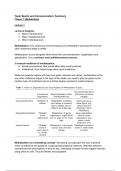Summary
Topic Sports and Communication Summary - all lectures & readings
- Course
- Institution
Topic Sports and Communication summary - written in English All lecture slides + readings summarised, theme 1-6 Edit: Grade on the exam was a 8.3 (9.3 with bonus point)
[Show more]



